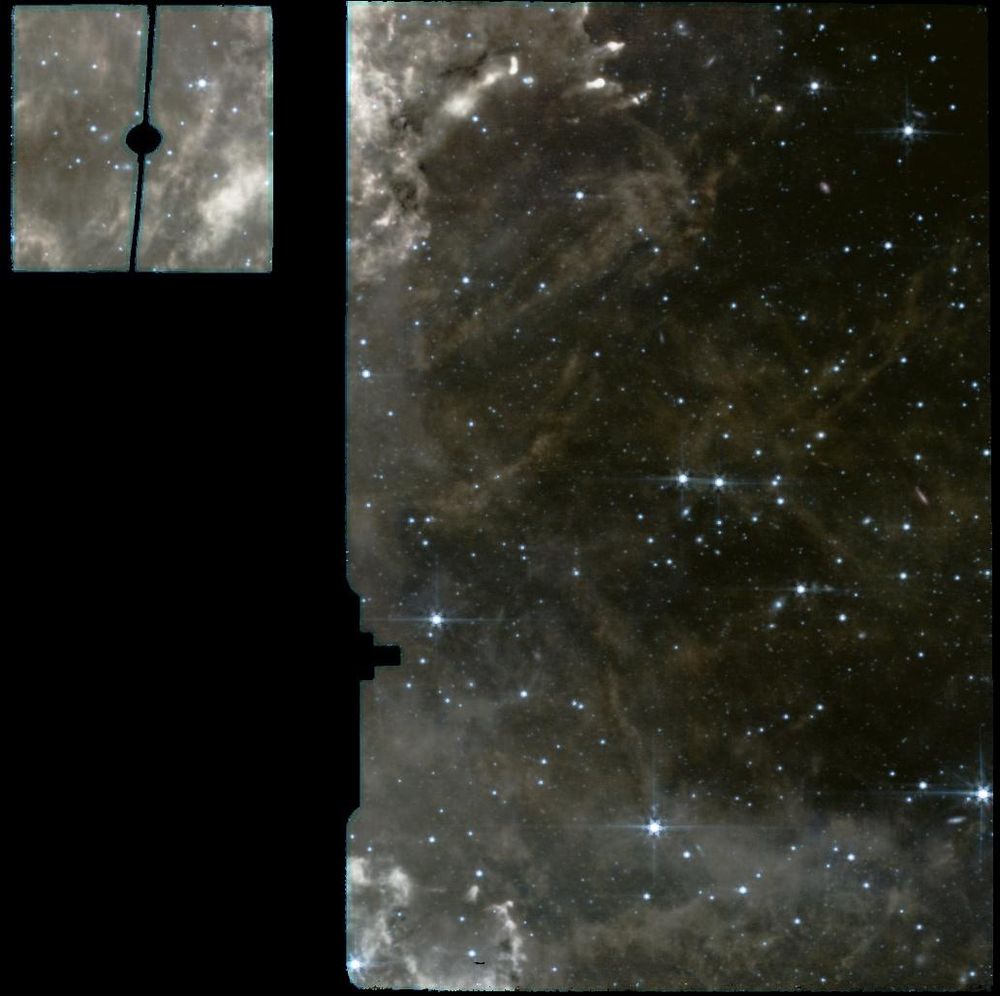
Mid-infrared view of a region in the LMC from MIRI. The image is composed of a small square image on the left and a larger rectangular image on the right, both revealing detailed structures of gas and dust clouds with embedded stars.
MIRI image of a region in LMC.
Processed by @yuvharpaz.bsky.social
nerdculture.de/@yuvharpaz/1...
11.03.2025 21:24 — 👍 252 🔁 16 💬 2 📌 1
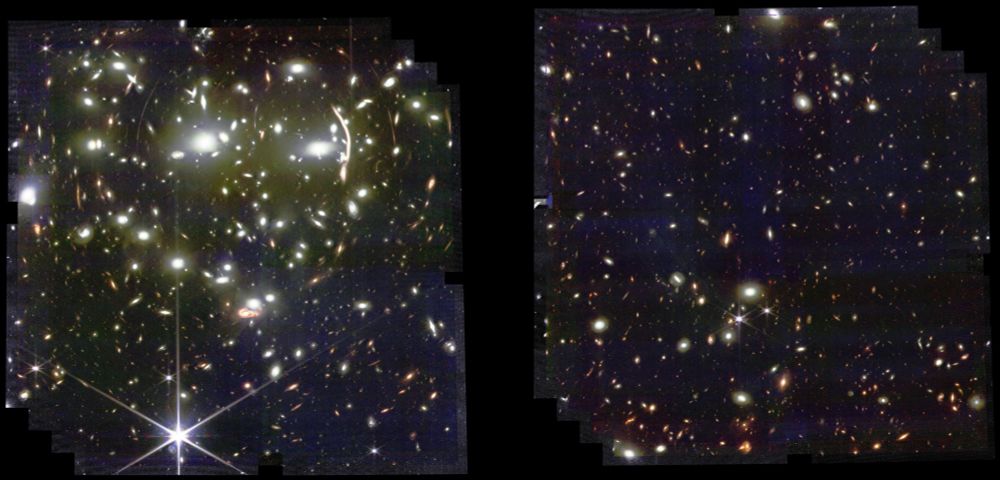
Wide-field view of the galaxy cluster Abell 370 captured by NIRCam. The image is split into two panels, each filled with a dense population of galaxies appearing as small, bright points of light against a dark background. Some galaxies show distinct spiral structures and lensing effects.
Abell 370, a cluster with plenty of gravitational lensing effect.
Processed by @yuvharpaz.bsky.social
nerdculture.de/@yuvharpaz/1...
11.03.2025 21:23 — 👍 184 🔁 24 💬 0 📌 0
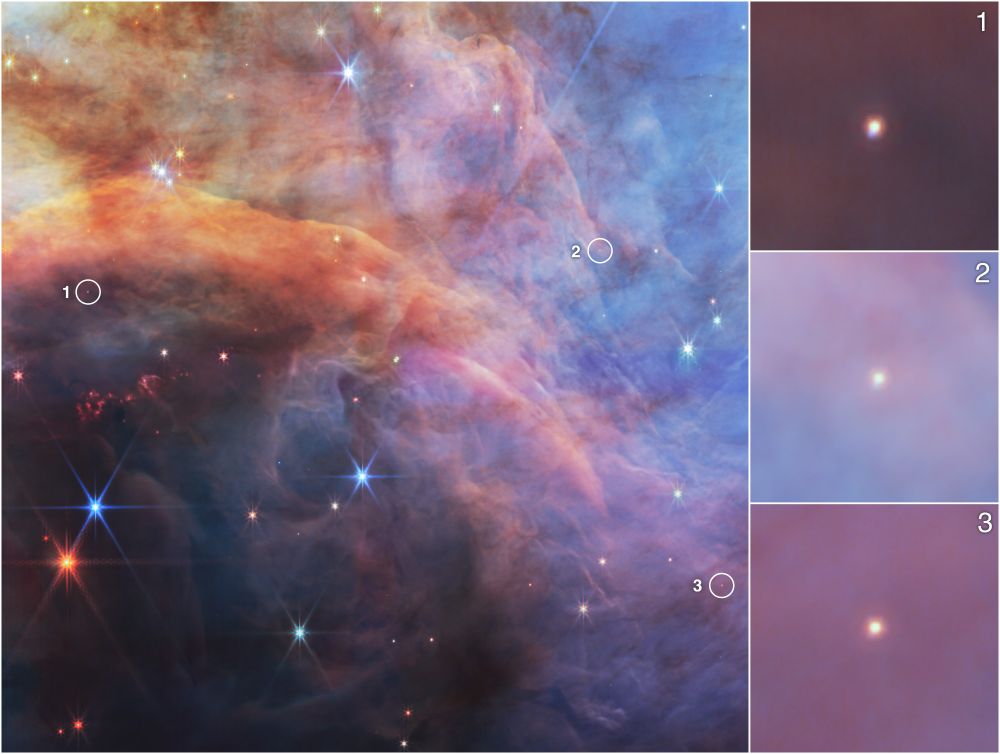
A collage of four images showing a dusty nebula. Two-thirds of the collage is taken up by a single image of the nebula, while the remaining third shows three insets stacked on top of each other. In the largest image at left, there is an orange and yellow fang-like cloud of matter that cuts the image in two. The left side of the fang shows more clouds of a dark brown shade, while the right shows filaments of light brown. There are a number of bright blue and red points of light spread throughout, three of which are circled in white and labeled with a number from one to three. Circle 1 is located at about 12 o’clock in the middle of the fang-like cloud, while Circle 2 is at about 5 o’clock and Circle 3 is located at about 7 o’clock, toward the bottom left of the image. Each circle magnifies an individual object, which is shown in each of the three squares to the right of the collage, labeled 1 to 3 from top to bottom. Each image contains a single, fuzzy point of light in the middle.
Low Mass Objects within the Flame Nebula in Infrared Light, in the new JWST image.
NASA, ESA, CSA, STScI, M. Meyer (University of Michigan)
10.03.2025 21:16 — 👍 365 🔁 37 💬 1 📌 2
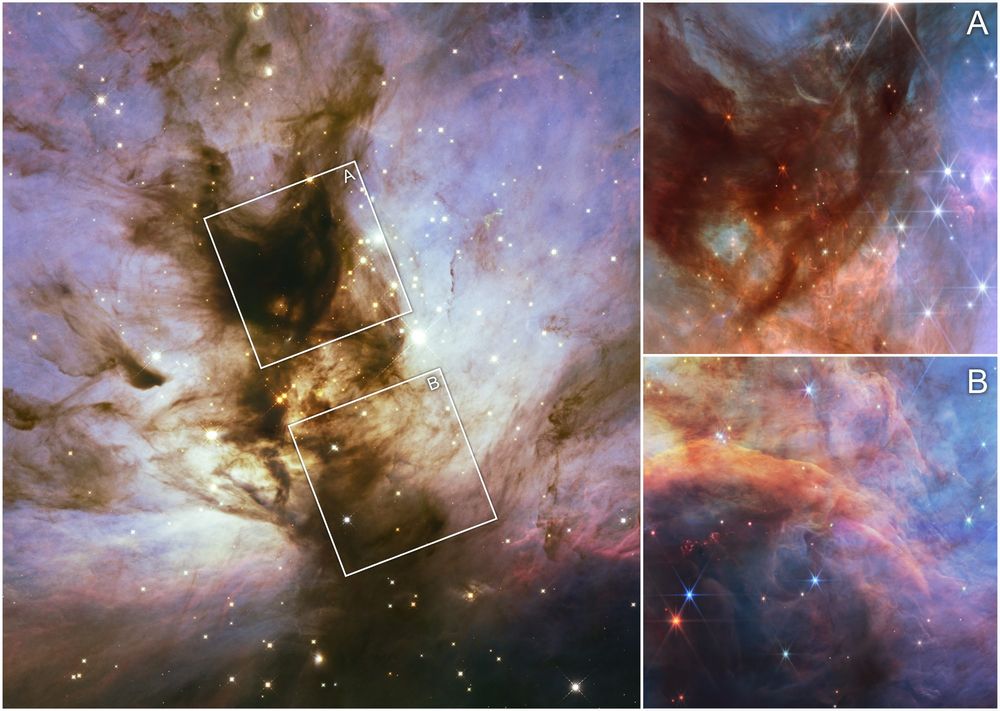
A collage of three near-infrared images showing a dusty nebula. The left two-thirds of the collage is taken up by a Hubble image of the nebula. The remaining third is taken up by two Webb images, one atop the other. The Hubble image has a pillar of dense brown dust running through the nebula at a diagonal from 5 o’clock to 11 o’clock. Wispy plumes appear to fly off from the pillar toward the sides amid blue clouds of the same material, which are whiter near the pillar. There are many white stars spread throughout. Two separate, white squares, tilted about 30 degrees, outline two areas in the pillar. The upper square has the letter “A” to the top right, while the lower square is marked by the letter “B”. These labels correspond to the two, magnified images of the nebula at right, with the top image also labeled “A” and the bottom image labeled “B”. Both images contain a mixture of reds, blues and browns, and show red, blue, and white stars.
New JWST image: portions of Flame nebula (right).
science.nasa.gov/missions/web...
NASA, ESA, CSA, STScI, Michael Meyer (University of Michigan), Matthew De Furio (UT Austin), Massimo Robberto (STScI), Alyssa Pagan (STScI)
10.03.2025 21:15 — 👍 301 🔁 35 💬 2 📌 2

A raw, black and white image of Lynds 483 showcasing a prominent, vertical jet structure emanating from a bright, compact source at the bottom. The jet appears as a luminous, textured column against a stark black background punctuated by numerous faint stars. The image emphasizes the structural details of the outflow without color information.
What a raw NIRCam image looks like.
This is Lynds 483, which its color-processed image was posted yesterday.
08.03.2025 20:56 — 👍 310 🔁 20 💬 1 📌 1

A NIRCam (Near-Infrared Camera) image of the dark cloud Lynds 483, highlighting a powerful bipolar jet. The jet is brightly illuminated with a mix of red, green, and blue hues, indicating different ionized gases and dust. It extends vertically from a bright, star-forming region at the bottom, against a backdrop of numerous faint stars. The image showcases the detailed structure and complex emissions within the cloud.
Baby solar system Lynds 483 (NIRCam image).
Processed by @yuvharpaz.bsky.social
nerdculture.de/@yuvharpaz/1...
08.03.2025 20:54 — 👍 1081 🔁 100 💬 19 📌 1
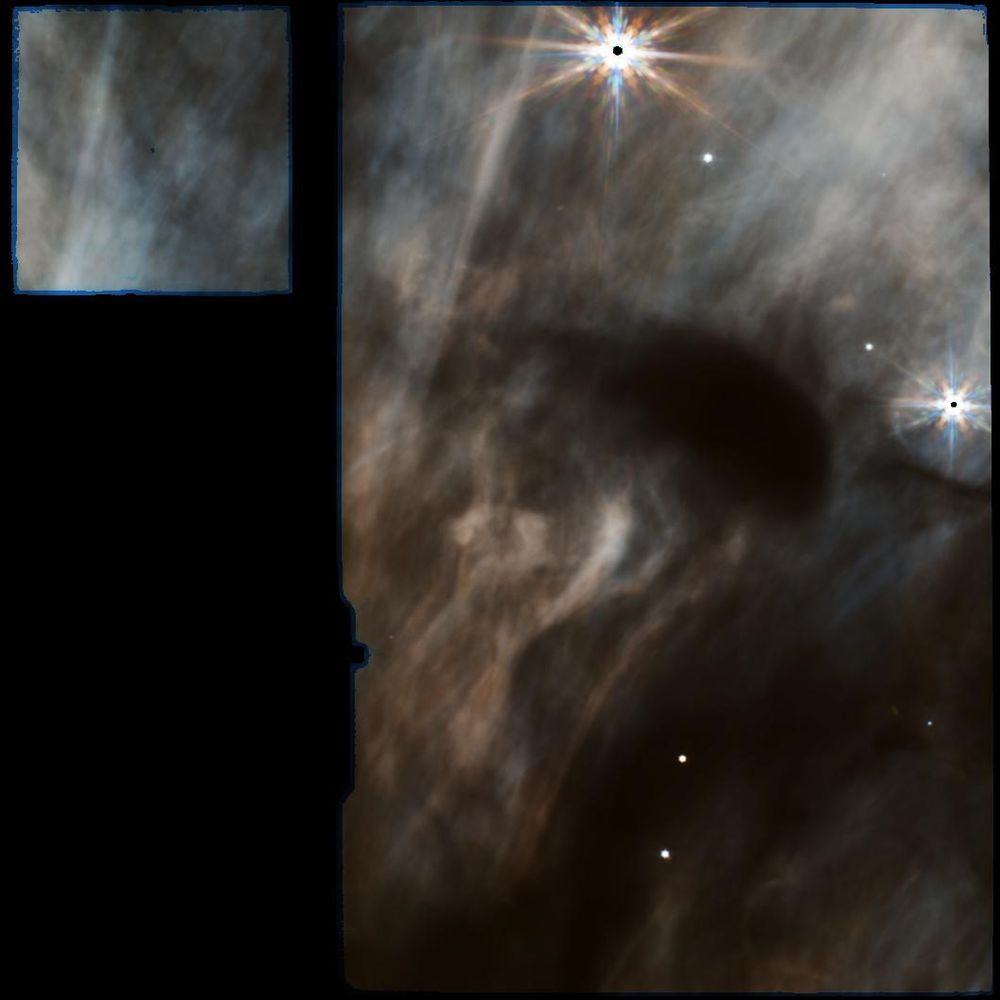
A MIRI (Mid-Infrared Instrument) image of the protostar HOPS-96. The image features a large, dark, amorphous cloud formation dominating the center, surrounded by wispy, illuminated nebulosity with hints of brown and orange tones. Two prominent stars with diffraction spikes are visible, along with several fainter point sources against a dark background. A smaller, square inset in the top left corner shows a fainter, more diffuse view of the same region.
HOPS-95 (MIRI image).
Processed by @yuvharpaz.bsky.social
nerdculture.de/@yuvharpaz/1...
08.03.2025 20:53 — 👍 279 🔁 17 💬 5 📌 0
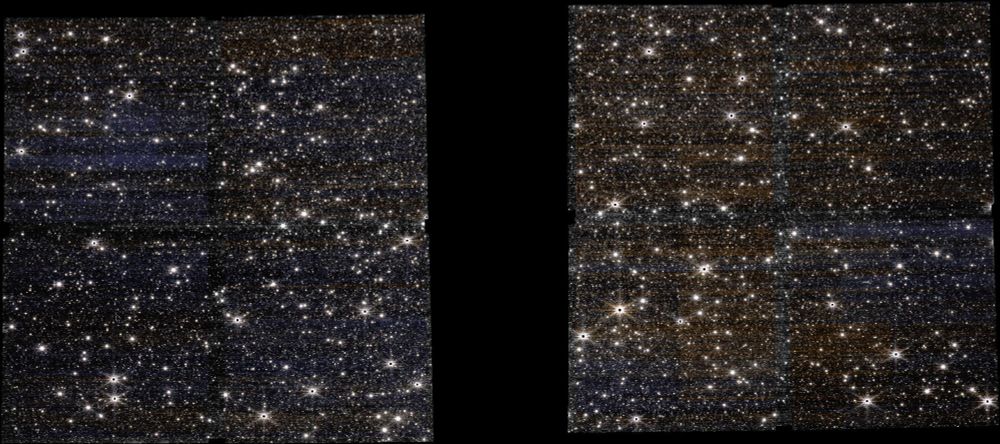
A side-by-side comparison of two slightly different Hubble Space Telescope images of NGC 5139, a globular cluster, showing a dense field of stars against a dark background.
Star cluster NGC 5139, NIRCam data.
Processed by @yuvharpaz.bsky.social
nerdculture.de/@yuvharpaz/1...
08.03.2025 20:52 — 👍 138 🔁 4 💬 3 📌 0
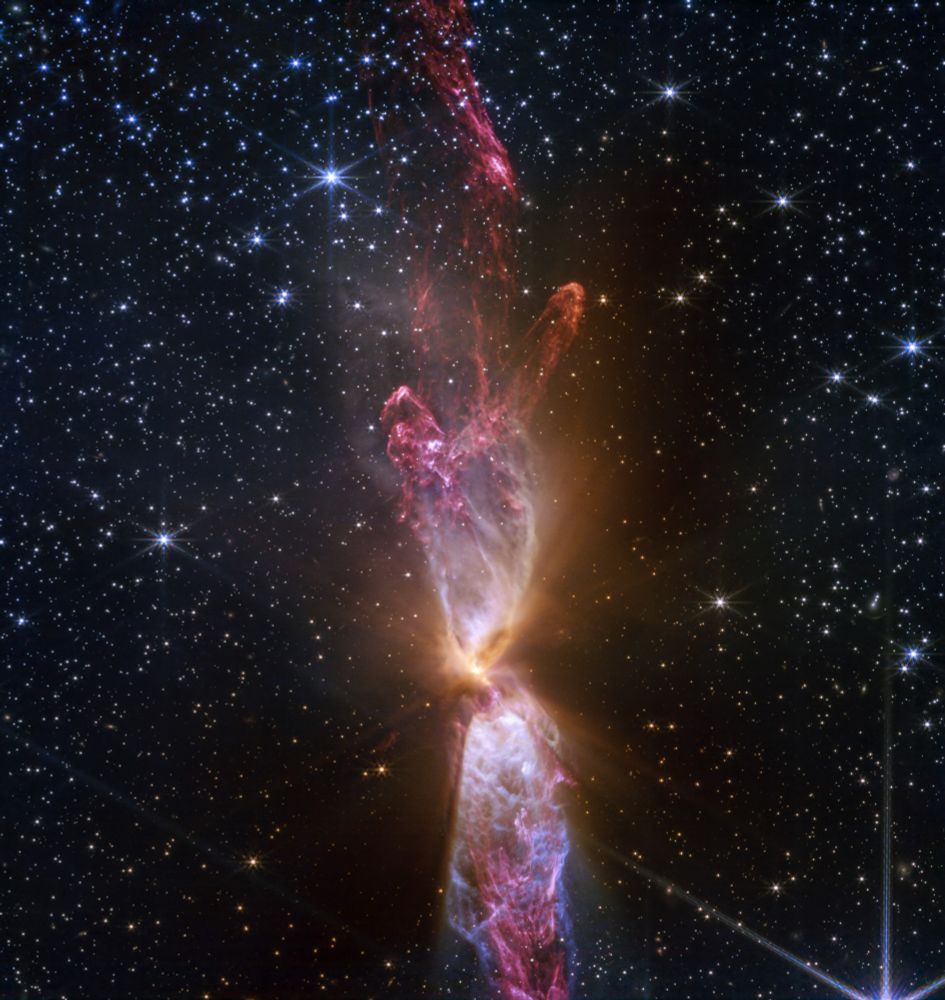
At the centre is a thin vertical cloud known as Lynds 483 (L483) that is roughly shaped like an hourglass with irregular edges. The lower lobe is slightly cut off. The top lobe is seen in full, petering out at the top.
New JWST image dropped: actively forming star system Lynds 483 (NIRCam image)
Credit:
NASA, ESA, CSA, STScI
esawebb.org/news/weic2503
07.03.2025 19:47 — 👍 2355 🔁 293 💬 26 📌 20
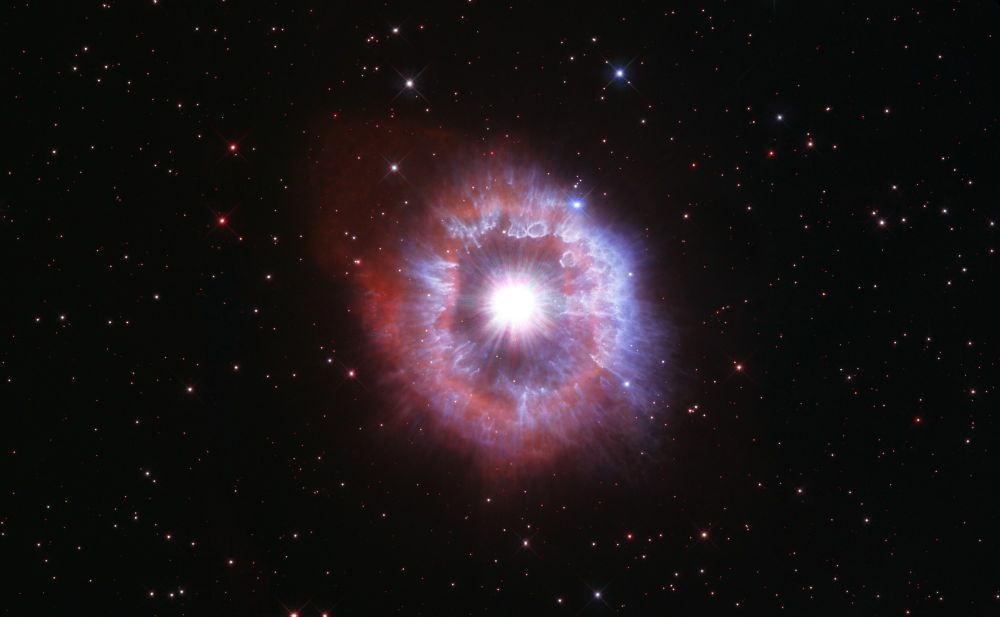
In celebration of the 31st anniversary of the launch of the NASA/ESA Hubble Space Telescope, astronomers aimed the celebrated observatory at one of the brightest stars seen in our galaxy to capture its beauty.
The giant star featured in this latest Hubble Space Telescope anniversary image is waging a tug-of-war between gravity and radiation to avoid self-destruction. The star, called AG Carinae, is surrounded by an expanding shell of gas and dust. The nebula is about five light-years wide, which equals the distance from here to our nearest star, Alpha Centauri.
Hubble's 31st anniversary image of AG Carinae.
Credit:
NASA, ESA and STScI
esahubble.org/images/heic2...
06.03.2025 21:28 — 👍 777 🔁 91 💬 8 📌 1
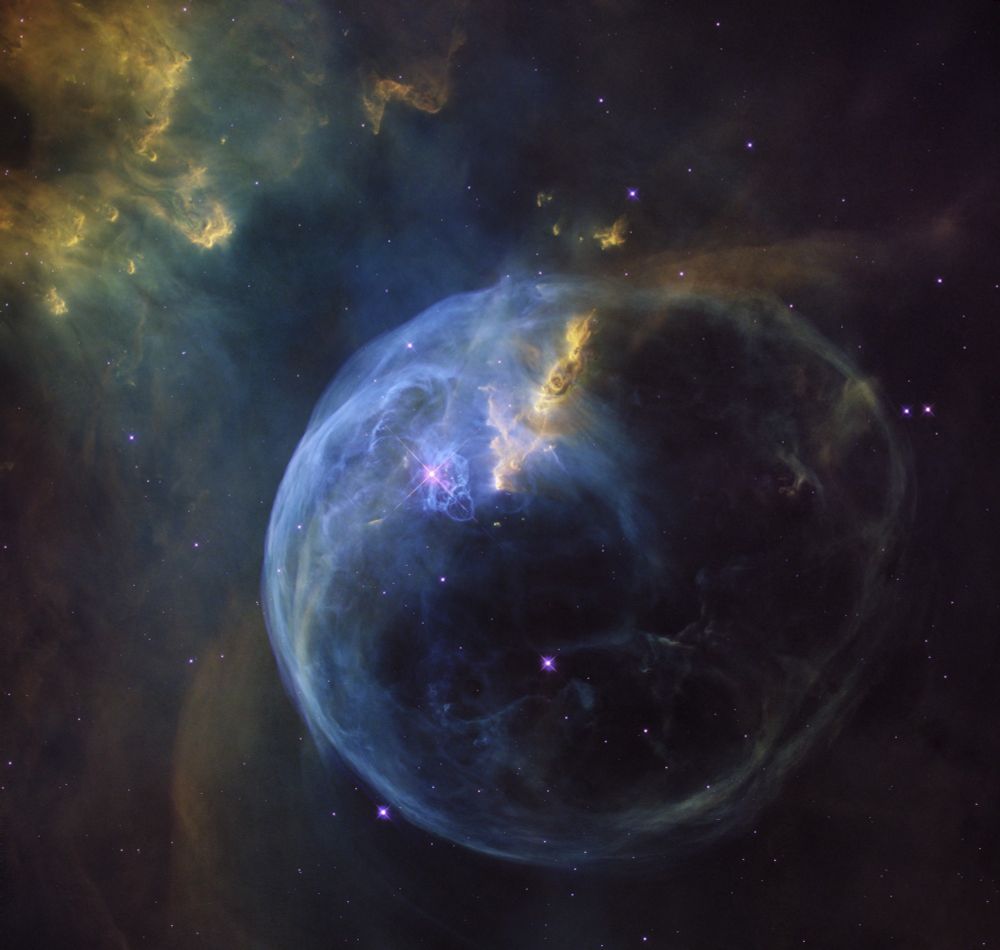
A Hubble Space Telescope image of the Bubble Nebula, showcasing a large, spherical shell of glowing gas with a distinct blue hue. Wisps of yellow and gold are visible along the edges and within the bubble's structure.
Bubble nebula.
Hubble image: NASA, ESA, Hubble Heritage Team.
05.03.2025 20:47 — 👍 540 🔁 75 💬 7 📌 3
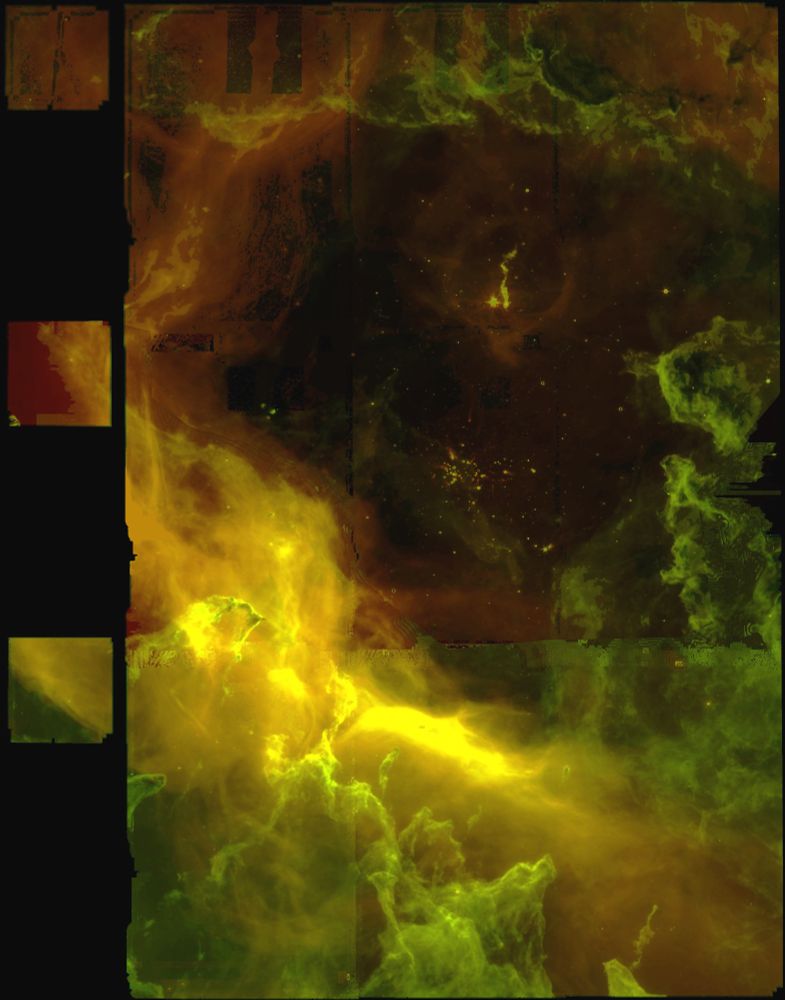
A MIRI (Mid-Infrared Instrument) image of the Westerlund 2 star-forming region featuring a complex nebula with bright yellow and green emission, revealing intricate structures and dark areas. The image is presented in a mosaic format with separate panels.
New MIRI data of Westerlund 2 was released earlier.
Data processed by @yuvharpaz.bsky.social
nerdculture.de/@yuvharpaz/1...
05.03.2025 20:44 — 👍 226 🔁 27 💬 2 📌 0
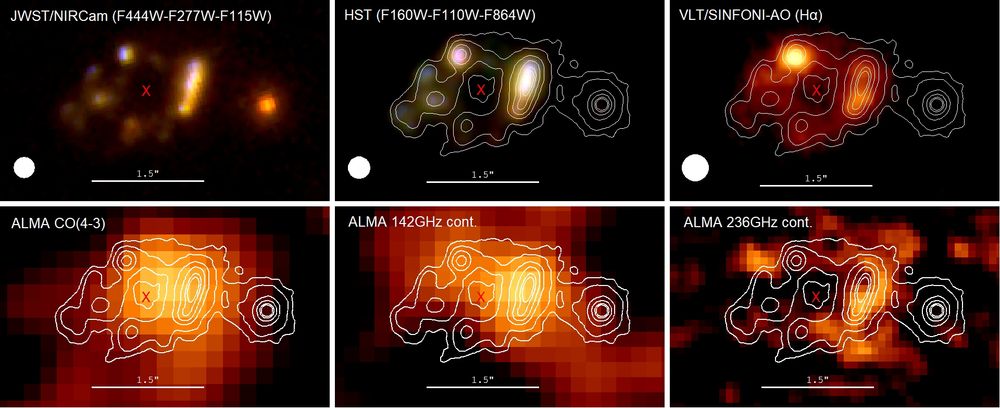
Imaging of zC406690 from various observations, showing a ring-like structure in spatially resolved images. The contours in all panels trace the JWST/NIRCam F444W emission. The Hα kinematic center is marked by the red cross. Top row: composite RGB image from NIRCam F115W, F277W and F444W (PSF matched to 0.15′′ using WebbPSF and Photoutils, left panel); composite RGB image from HST H, J and F814W bands (PSF 0.15′′, middle panel); Top right: Hα moment zero map from VLT/SINFONI (PSF 0.18′′, right panel). Bottom row: low-resolution ALMA archival observations of the CO(4-3) emission (PSF
1.5′′, integrated S/N=7), 142GHz continuum (PSF 1.5′′, peak S/N=4.5) and 236 GHz continuum (PSF 0.74′′, peak S/N=2.5).
A large-scale ring galaxy at z=2.2 revealed by JWST/NIRCam.
arxiv.org/abs/2503.008...
05.03.2025 20:42 — 👍 138 🔁 5 💬 0 📌 0
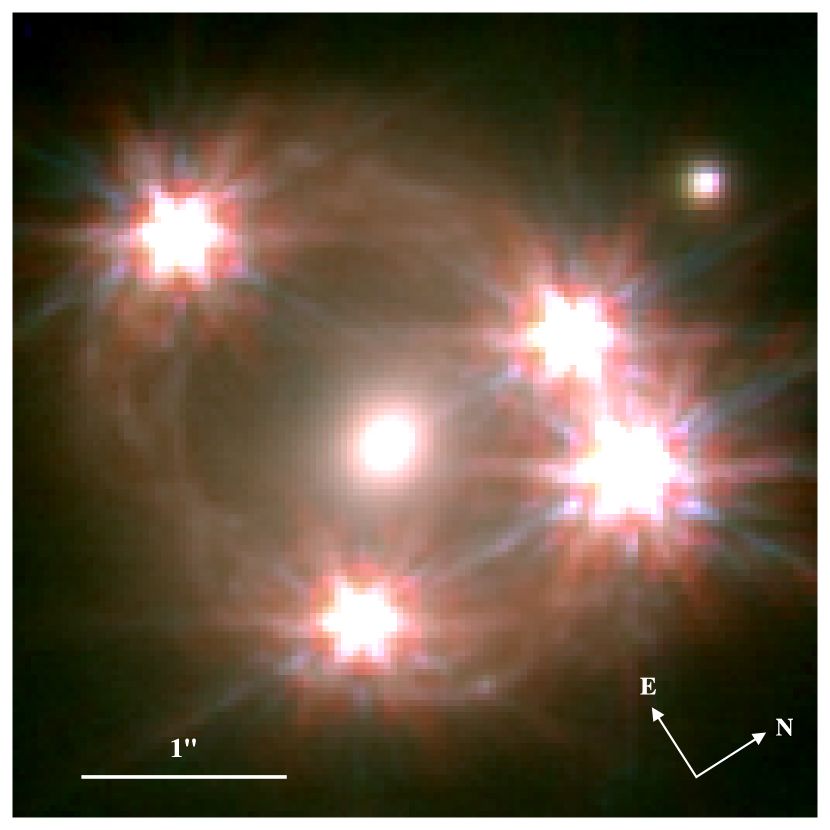
JWST NIRCam color image of WFI2033-4723 (GTO Program #1198; PI: Stiavelli). The F115W band is mapped to the luminosity and blue, F150W to cyan, F277W to yellow, and the F356W band to red. Near the bottom image, there is a bright spot on the lower-right side that maps back to other bluer regions of the ring, indicating it is a multiply-imaged star-forming region (SFR) contained in the z∼1.6 host. Preliminary models place the physical size at ∼150pc located ∼2kpc from the center of the galaxy (assuming flat CDM cosmology with h = 0.7 and m = 0.3).
New NIRCam image of WFI2033-4723, a quadruply-imaged quasar, was released in a recent article.
arxiv.org/abs/2503.000...
05.03.2025 20:40 — 👍 223 🔁 23 💬 3 📌 4

This mid-infrared image from MIRI showcases the planetary nebula NGC 1514, often called Crystal Ball Nebula. It appears as a roughly spherical, glowing cloud with a complex structure. The nebula exhibits a range of colors, from a bright white outer shell to a mottled interior of red, pink, and blue hues, suggesting varying temperatures and compositions of the ejected stellar material. A bright central star is visible at the nebula's core, surrounded by a faint, star-like halo. The dark background is sprinkled with a few distant stars, while the bottom right corner of the image includes text stating "Processing M. Hakan Özsaraç Science NASA, ESA, CSA, STScI".
NGC 1514 (MIRI image).
M. Hakan Özsaraç Science NASA, ESA, CSA, STScI
www.flickr.com/photos/mhozs...
04.03.2025 20:37 — 👍 1786 🔁 192 💬 50 📌 12

NIRCam captures the detailed structure of NGC 5643, a spiral galaxy with a bright core and prominent spiral arms. The image highlights the instrument's ability to resolve dust lanes and star formation regions, as well as the diffraction patterns of foreground stars.
NGC 5643 (NIRCam image).
Processed by @thocarp.bsky.social
www.flickr.com/photos/19746...
04.03.2025 20:34 — 👍 258 🔁 36 💬 2 📌 1
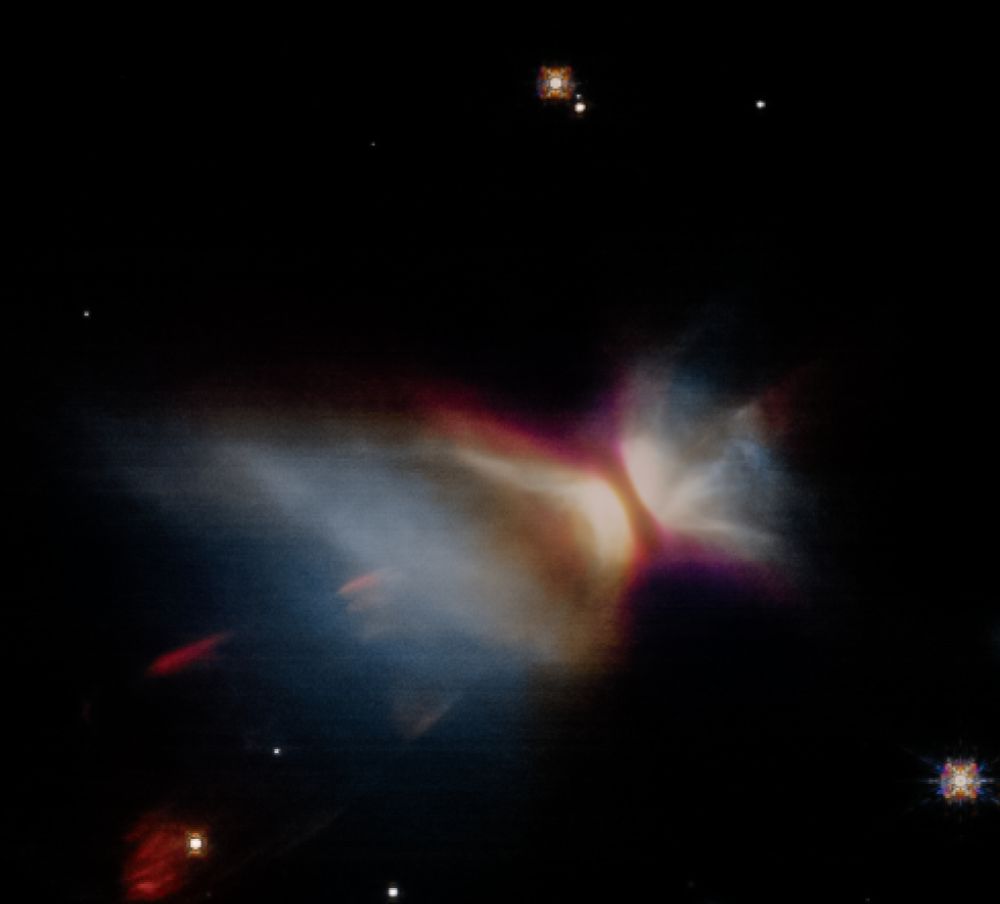
This infrared image shows a faint, hazy nebula surrounding the protostar CB-26. The nebula has wispy clouds of red, orange, and white, set against a dark background sprinkled with stars. Two brighter stars shine near the top, and a smaller, redder nebula can be seen at the bottom left.
Protostar CB-26 (NIRCam image).
Processed by @thocarp.bsky.social
www.flickr.com/photos/19746...
04.03.2025 20:33 — 👍 567 🔁 53 💬 1 📌 2
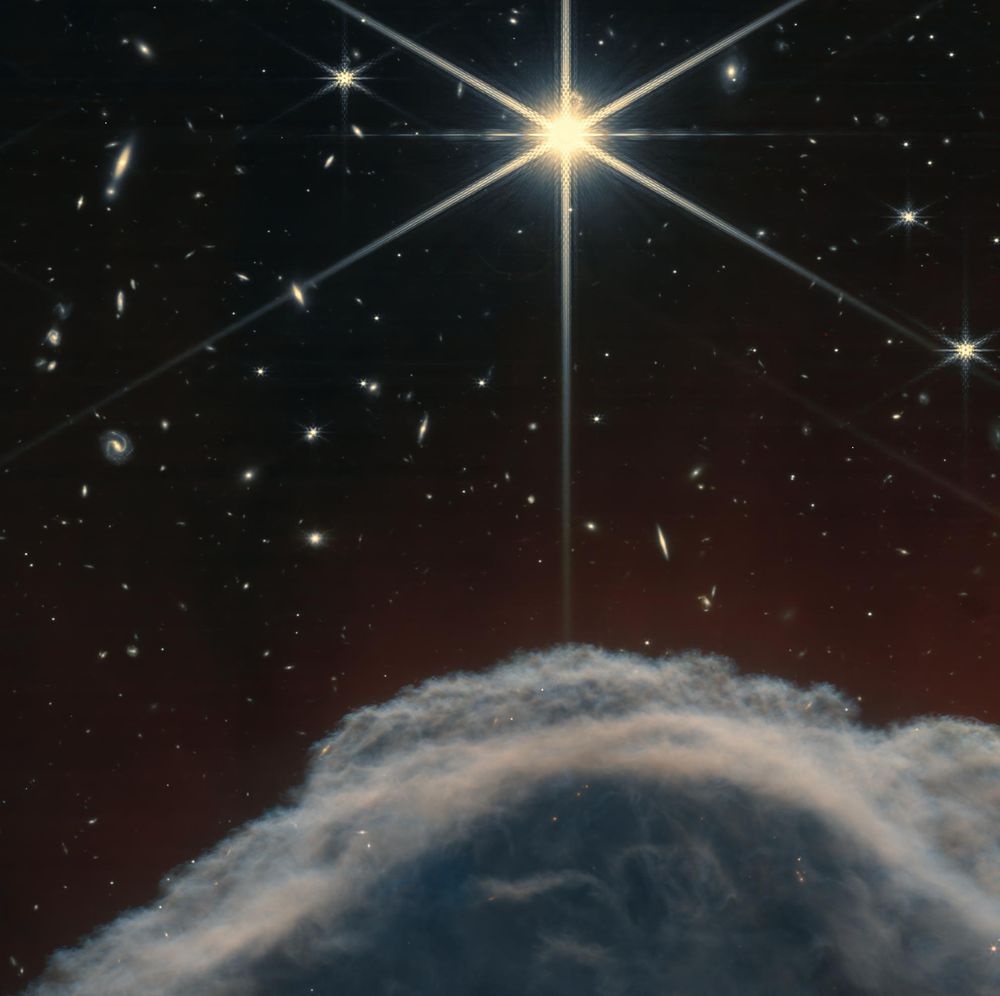
A close-up view of the Horsehead Nebula's edge captured by NIRCam, revealing the intricate texture of the cloud's upper layer. A central bright star, with its characteristic eight-pointed diffraction spikes, dominates the image. Faint, distant galaxies are scattered throughout the deep space background, which has a reddish tint.
Tip of Horsehead nebula, by JWST (NIRCam).
Processed by George Hatfield.
www.astrobin.com/cuw5ti
03.03.2025 21:02 — 👍 1018 🔁 91 💬 10 📌 4
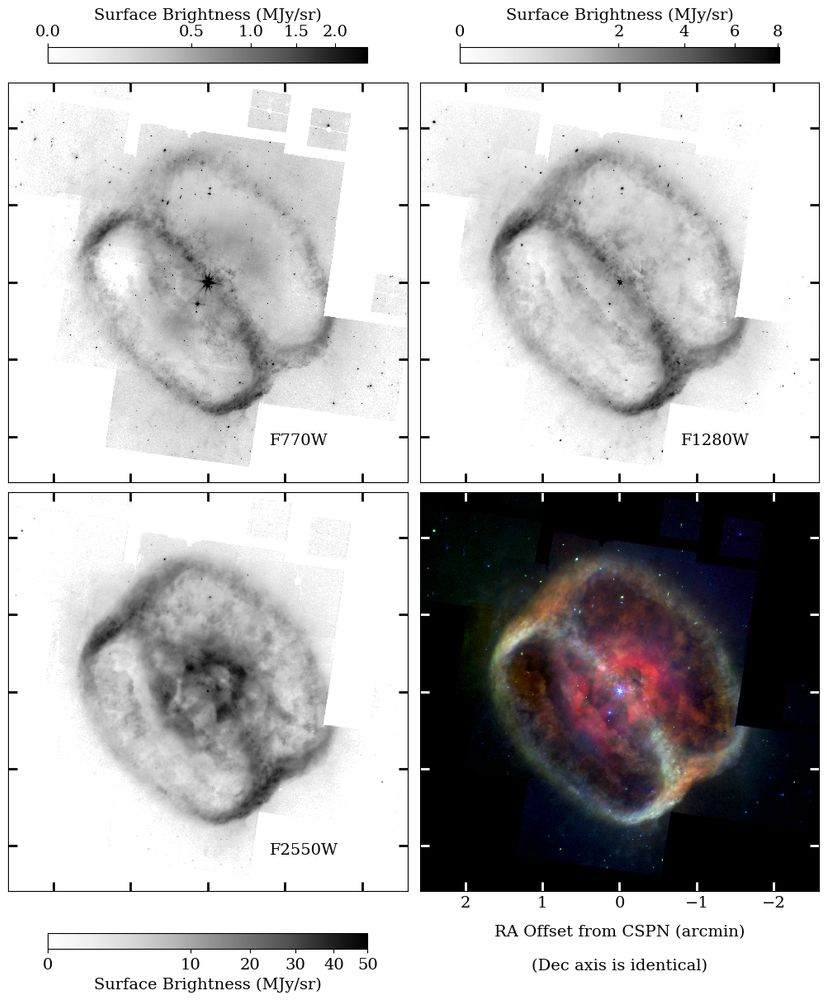
Coadded images of NGC 1514 at 7.7 µm (upper left), 12.8 µm (upper right), 25.5 µm (lower left), and a three-color composite image of the three. The origin (0′,0′) corresponds to the position of the central binary star.
New MIRI image of NGC 1514 was released in a recent article.
arxiv.org/abs/2502.212...
03.03.2025 21:01 — 👍 345 🔁 33 💬 8 📌 3
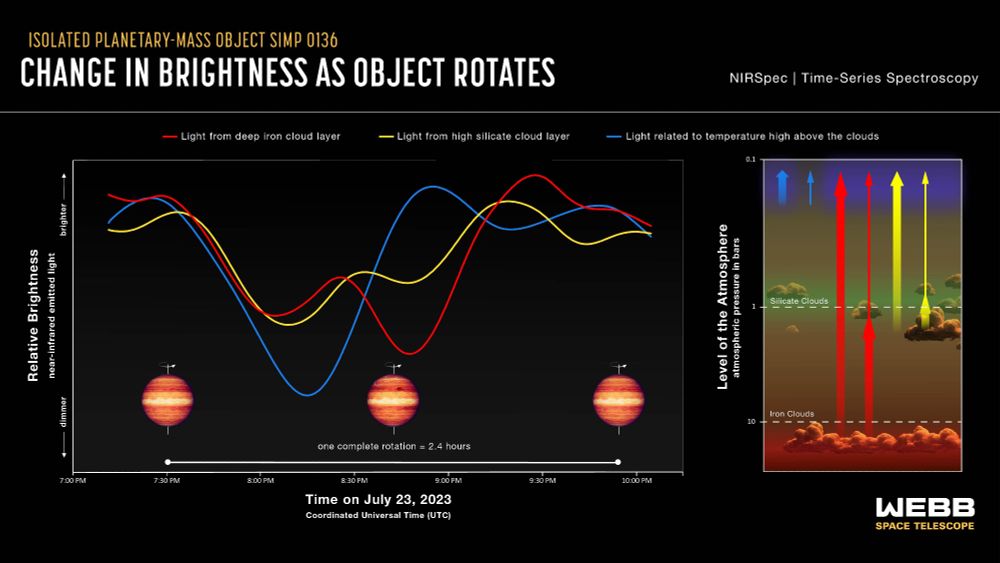
The graphic has two parts. On the left are light curves showing the change in brightness of three sets of near-infrared wavelengths over time. On the right is a cross-section of the object’s atmosphere, showing the altitude that each set of wavelengths originates and their relationship to cloud layers or temperature.
As promised yesterday:
NASA's Webb Exposes Complex Atmosphere of Starless Super-Jupiter.
webbtelescope.org/contents/new...
03.03.2025 16:00 — 👍 208 🔁 13 💬 2 📌 2
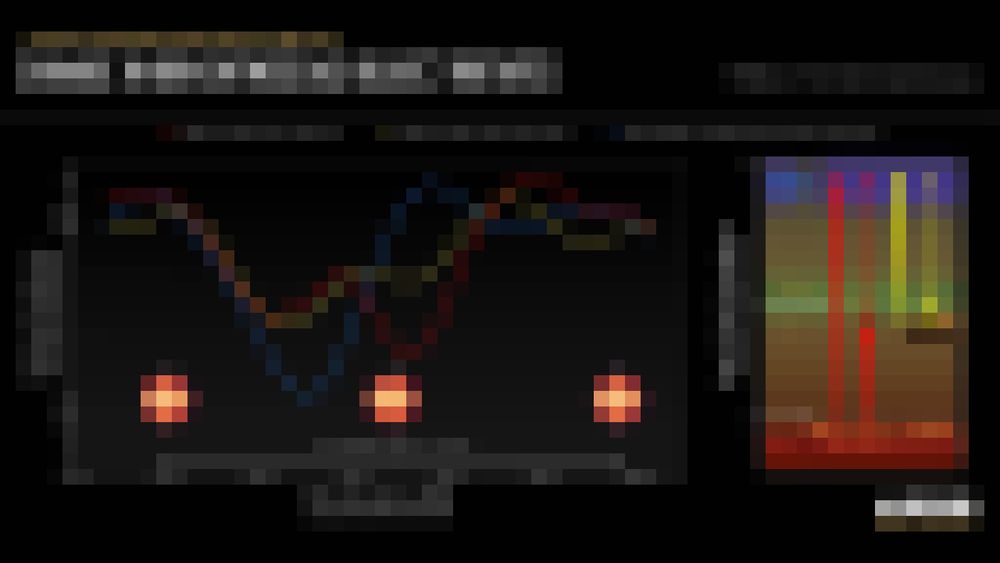
Heavily pixelated screenshot of a data visualization dashboard, showing a line graph on the left and a vertical bar graph on the right. The image is dark with bright colored lines and bars.
The next JWST release will be a detection of Iron clouds and Silicate clouds on exoplanet SIMP-0136.
02.03.2025 19:47 — 👍 203 🔁 8 💬 4 📌 1
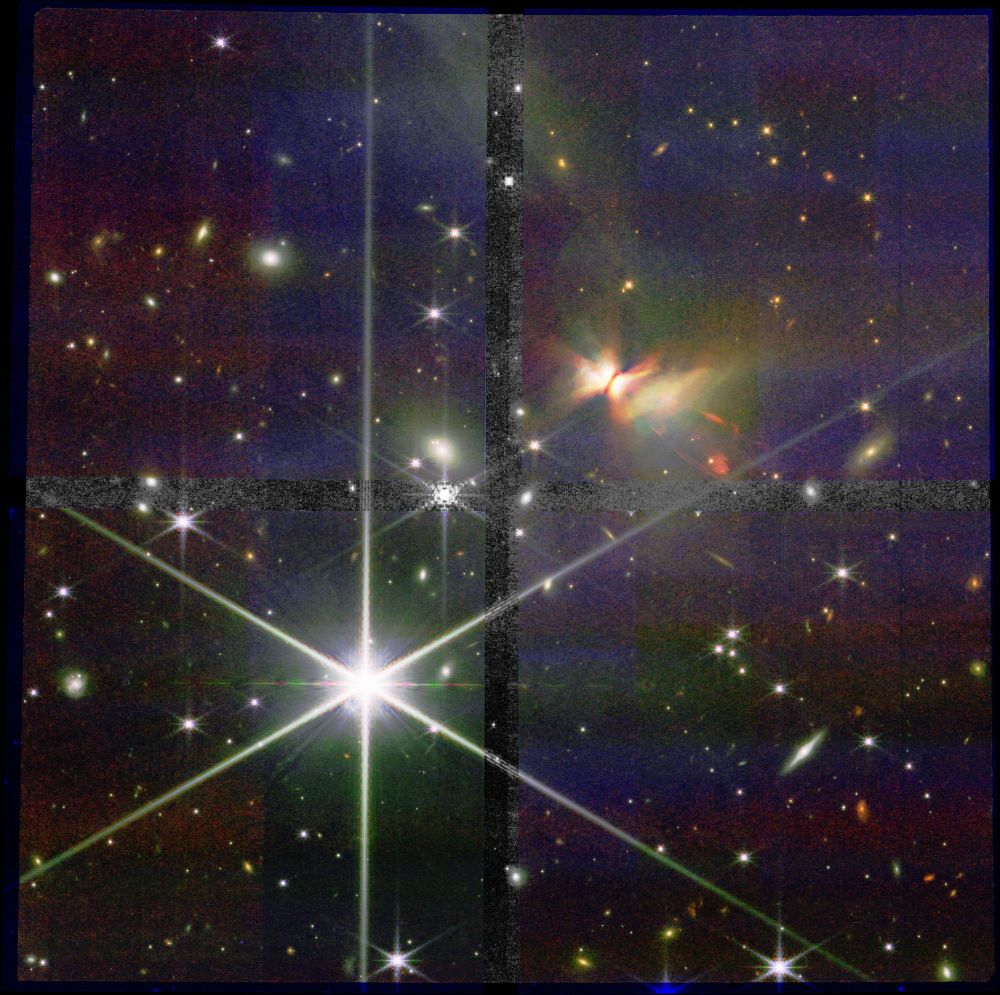
A multi-colored infrared image of protostar CB-26 captured by the NIRCam instrument. The central star is intensely bright, exhibiting a prominent eight-pointed diffraction spike pattern due to the telescope's optics. The surrounding nebula displays a complex mix of colors, indicating different temperatures and compositions of gas and dust. A distinct reddish-orange structure is visible to the upper right of the central star, suggesting outflows or jets. The image is composed of four distinct quadrants, with noticeable black seams separating them. Numerous fainter stars and galaxies are scattered throughout the background.
In addition, new NIRCam & MIRI data of protostar CB-26 have been released today.
This NIRCam one was processed by @yuvharpaz.bsky.social
nerdculture.de/@yuvharpaz/1...
01.03.2025 22:13 — 👍 676 🔁 61 💬 6 📌 1
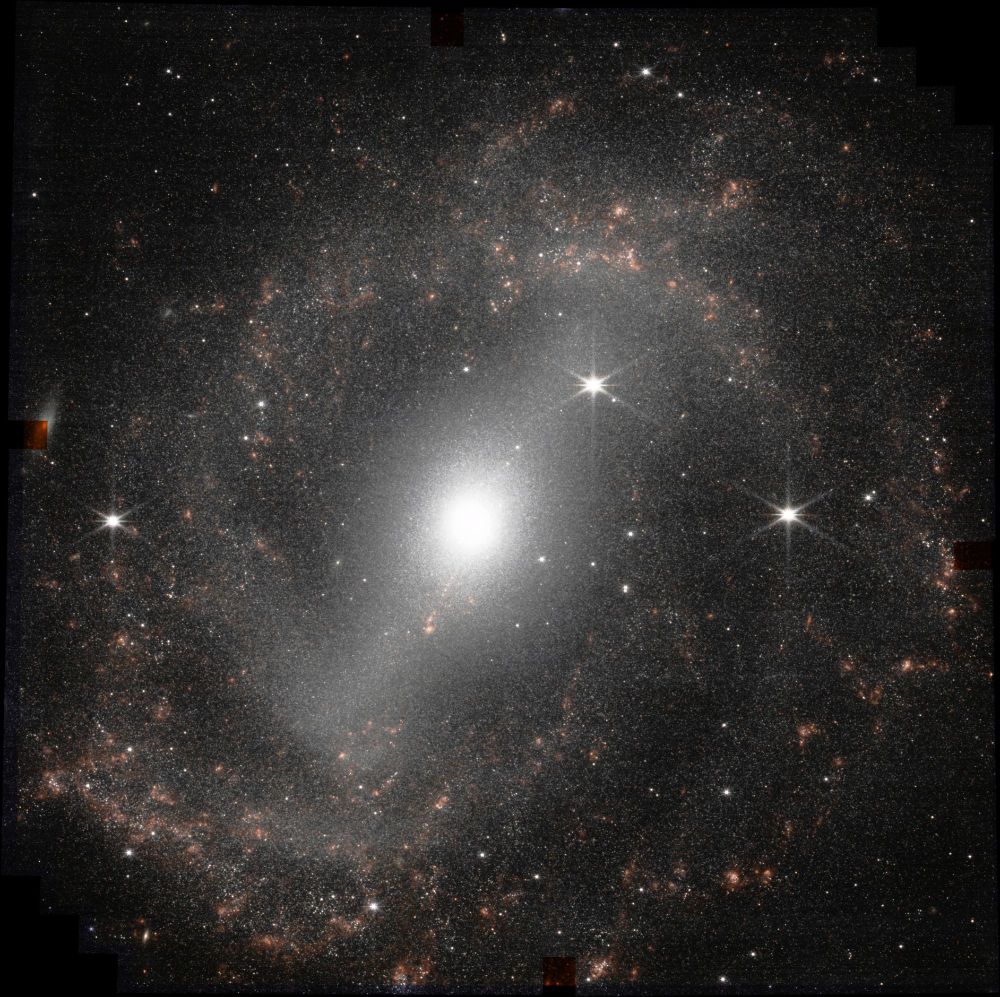
A black and white, full-view image of the galaxy NGC 5643 taken by the NIRCam instrument. The galaxy has a prominent, bright white core that fades into a smooth, elliptical shape. The surrounding halo is speckled with individual stars and shows a mottled texture, indicating areas of varying star density and dust. The image is composed of multiple tiles, with faint black seams visible at the edges of each tile. Four prominent diffraction spikes are visible, emanating from bright stars within the galaxy, creating a cross-like pattern.
JWST observed NGC 5643 yesterday, using NIRCam.
This data was processed by @yuvharpaz.bsky.social
nerdculture.de/@yuvharpaz/1...
01.03.2025 22:11 — 👍 598 🔁 51 💬 1 📌 3
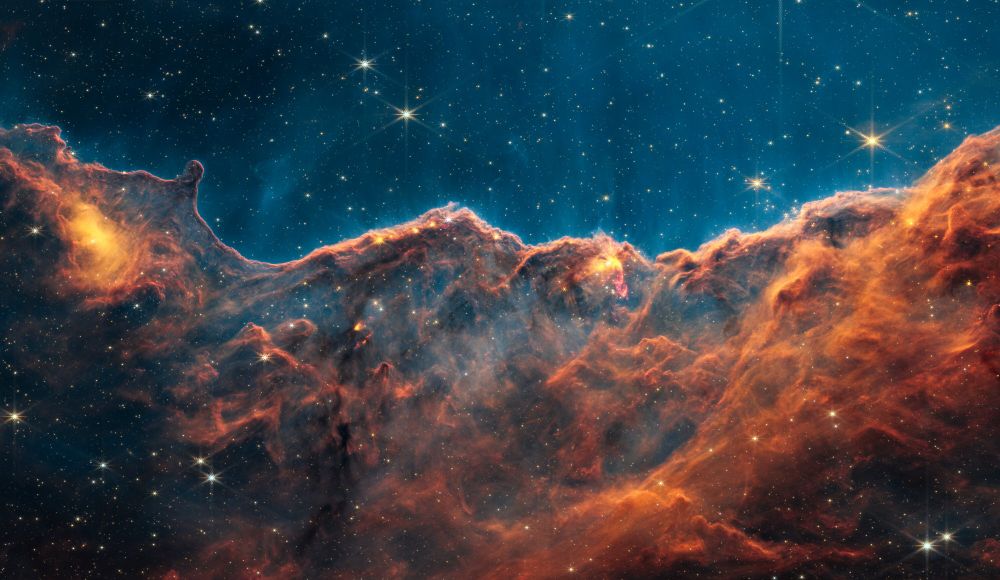
The image is divided horizontally by an undulating line between a orange-burgundy cloudscape forming a nebula along the bottom portion and a comparatively blue upper portion. Speckled across both portions is a starfield, showing innumerable stars of many sizes.
Carina Nebula Jets (NIRCam Narrowband Filters).
NASA, ESA, CSA, and STScI, J. DePasquale (STScI)
01.03.2025 20:36 — 👍 437 🔁 57 💬 7 📌 2
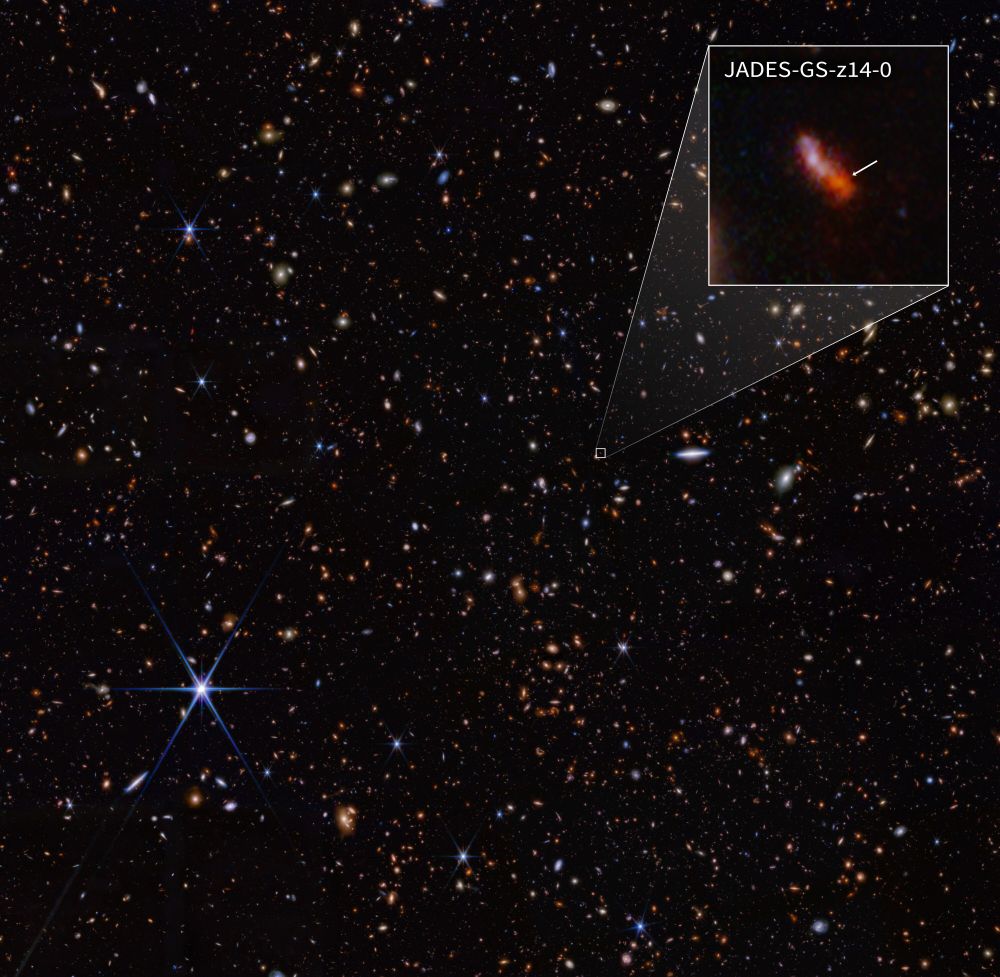
A field of thousands of small galaxies of various shapes and colors on the black background of space. A bright, foreground star with diffraction spikes is at lower left. Near the image center, a tiny white box outlines a region and two diagonal lines lead to a box in the upper right. Within the box is a banana-shaped blob that is blueish-red in one half and distinctly red in the other half. An arrow points to the redder portion and is labeled “JADES GS z 14 – 0”.
Most distant object known to humanity - JADES-GS-z14-0.
NASA, ESA, CSA, STScI, B. Robertson (UC Santa Cruz), B. Johnson (CfA), S. Tacchella (Cambridge), P. Cargile (CfA)
01.03.2025 00:03 — 👍 1518 🔁 151 💬 41 📌 18
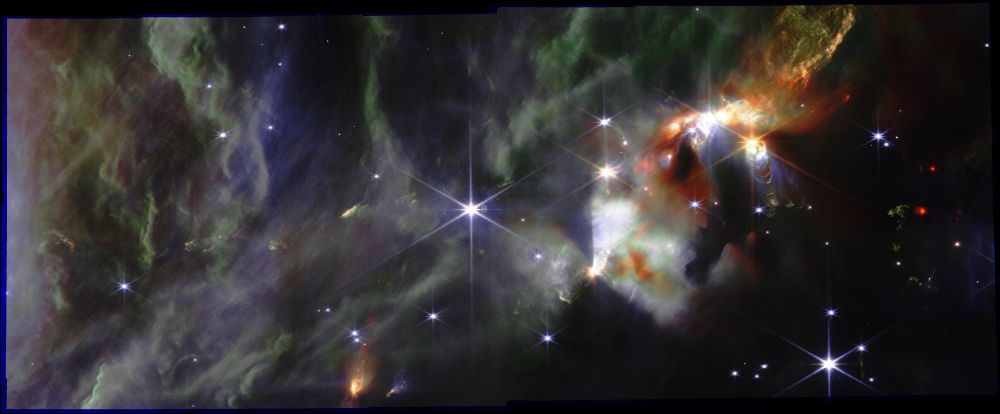
This NIRCam image reveals the OMC2-SE region, showcasing a vast expanse of interstellar gas and dust. The left side is dominated by wispy, cloud-like structures in shades of green and gray, suggesting the presence of cooler gas and dust. Scattered throughout are numerous bright stars, some with visible diffraction spikes. On the right, a denser region exhibits a mix of red and white nebulosity, indicating areas of active star formation and ionized gas. A particularly bright star shines at the center of this region, illuminating the surrounding clouds. The overall image has a dark background, highlighting the luminous details of the nebula.
Another part of OMC2 by JWST.
This one is OMC2-SE.
Processed by @yuvharpaz.bsky.social
nerdculture.de/@yuvharpaz/1...
28.02.2025 19:51 — 👍 306 🔁 30 💬 2 📌 0

A spiral galaxy seen close up and almost face on. It is filled with puffy, patchy clouds of hot gas and dust. Red, orange and yellow colours indicate light emitted by different particles. The brightest colours are in the centre and along the two spiral arms, which wind out from the centre. Star clusters hide in the gas along the arms. A few large, bright white stars are prominent in the foreground, near to us.
New JWST image dropped: NGC 2283.
ESA chose this spiral galaxy to be Picture Of The Month (POTM) for February 2025.
ESA/Webb, NASA & CSA, A. Leroy
esawebb.org/images/potm2...
28.02.2025 16:29 — 👍 2086 🔁 234 💬 24 📌 8
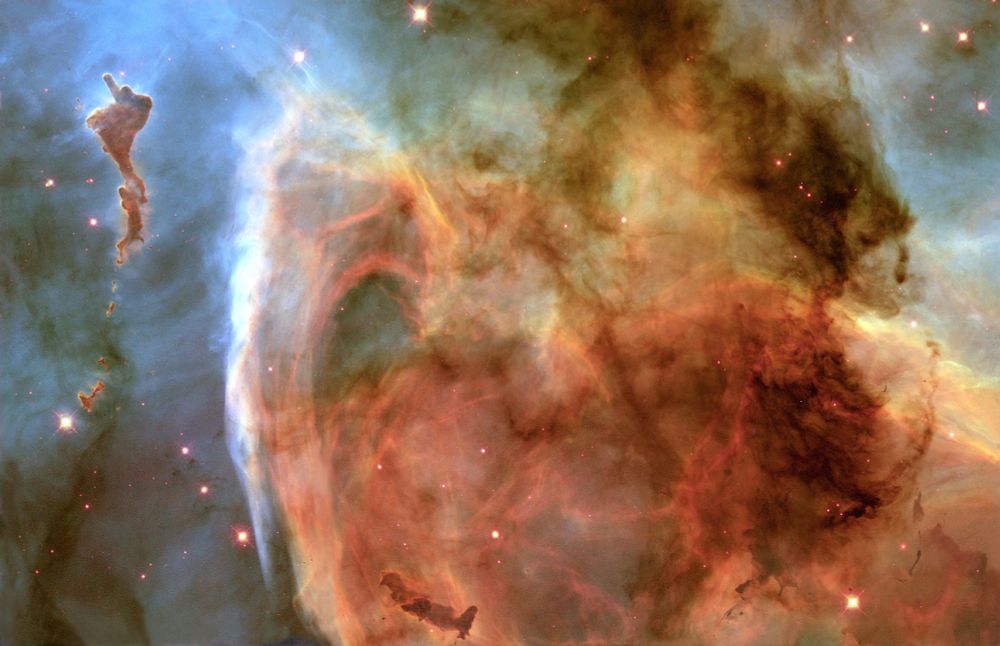
Previously unseen details of a mysterious, complex structure within the Carina Nebula (NGC 3372) are revealed by this image of the 'Keyhole Nebula, ' obtained with the Hubble Space Telescope. The picture is a montage assembled from four different April 1999 telescope pointings with Hubble's Wide Field Planetary Camera 2, which used six different colour filters. The picture is dominated by a large, approximately circular feature, which is part of the Keyhole Nebula, named in the 19th century by Sir John Herschel. This region, about 8000 light-years from Earth, is located adjacent to the famous explosive variable star Eta Carinae, which lies just outside the field of view toward the upper right. The Carina Nebula also contains several other stars that are among the hottest and most massive known, each about 10 times as hot, and 100 times as massive, as our Sun.
Light and shadow in the Carina Nebula.
NASA/ESA, The Hubble Heritage Team (AURA/STScI).
27.02.2025 22:00 — 👍 1279 🔁 134 💬 14 📌 7
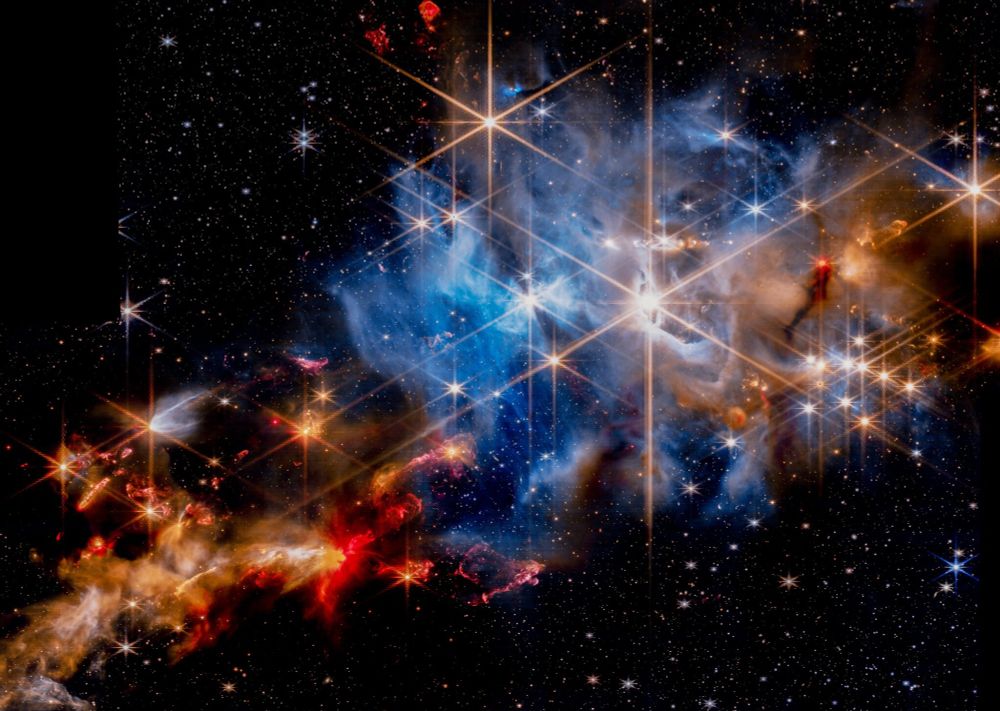
A stunning infrared image from the James Webb Space Telescope's NIRCam instrument captures the Serpens Nebula, a region of active star formation. 1 The image is dominated by a bright blue central region, where intense radiation from young stars illuminates the surrounding gas and dust. This blue core is enveloped by wisps and tendrils of orange and red nebulosity, creating a visually dynamic and colorful scene. Numerous bright stars are scattered throughout the image, each exhibiting the characteristic eight-pointed starburst pattern caused by the telescope's optics. The intricate textures and contrasting colors reveal the complex processes of star birth within this nebula
Serpens nebula (NIRCam image).
Processed by @thocarp.bsky.social
www.flickr.com/photos/19746...
27.02.2025 17:10 — 👍 973 🔁 122 💬 6 📌 4

A detailed infrared image from the James Webb Space Telescope's NIRCam instrument showcases the OMC2 region, a vibrant star-forming area within the Orion Nebula. The image is dominated by swirling clouds of gas and dust, rendered in shades of red and white, creating a dramatic and dynamic scene. Numerous bright stars are scattered throughout, their brilliance accentuated by prominent eight-pointed diffraction spikes, a characteristic feature of the telescope's optics. The intricate textures and interplay of light and shadow reveal the complex processes of star formation in this active region.
Gorgeous OMC2 (NIRCam image).
This is one of the most active sites of ongoing low and intermediate-mass star formation known today.
Processed by @thocarp.bsky.social
www.flickr.com/photos/19746...
27.02.2025 16:55 — 👍 271 🔁 32 💬 2 📌 2





























